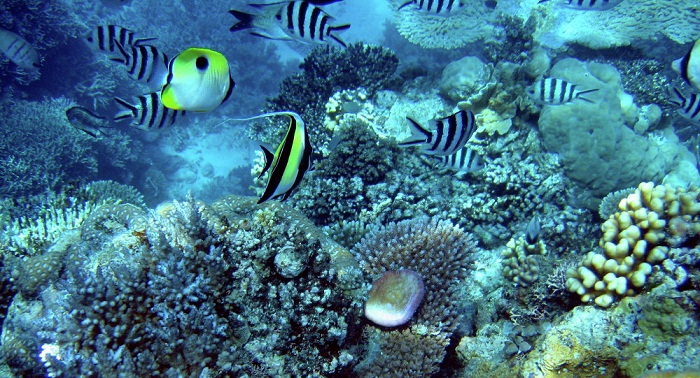The report card measures the progress towards water pollution targets, as well as the overall health of the Great Barrier Reef’s ecosystems, including coral and seagrass.
Combining all the measurements, the reef was rated D or “poor”.
Many of the individual assessments of progress towards water-quality targets showed very slow progress.
The government has a target to reduce inorganic nitrogen flowing into the Great Barrier Reef – mostly from sugar-cane fertilisation – by 50%. The report card rated progress towards that target with an E or “very poor”, finding it had only been reduced by 18.1%.
Progress towards improving sugar-cane farming and grazing practices in Great Barrier Reef catchments was rated “poor”, as was progress towards sediment and pesticide targets.
Some improvement was seen in coral cover in “inshore reefs” – those closest to the coastline – with their score moving from a D to a C.
But the coral cover in the most northerly sections – Cape York and the Wet Tropics – were given a score of D.
Those northern sections, particularly Cape York, were the hardest hit by the 2016 bleaching event, which occurred after the data used for this report card was collected.
Initial estimates show that 22% of the coral along the whole Great Barrier Reef was killed in the event, with 85% of that mortality occurring in the northern tip, north of Lizard Island.
The results follow a Water Science Taskforce report from the Queensland government in August finding $8.2bn was needed to meet water-quality targets the government has committed to, in order to avoid having the reef included on the world heritage in-danger list.
The new report card said “hundreds of millions” were being spent on projects to reduce pollution.
The government will need to report to the UN’s world-heritage committee in December on implementation of its plan to meet those targets, including on whether the plan has been adequately funded.
Imogen Zethoven from the Australian Marine Conservation Society described the report as “startling”.
“Coral bleaching, crown-of-thorn outbreaks and the ongoing poor condition of inshore reefs – these are the visible signs of a reef in crisis and the need for urgent action on water quality,” she said.
“The reef can’t survive and thrive without clean water. We must see accelerated action by the Queensland government to move ahead with legislative caps on water quality, supported by the federal government,” Zethoven said.
Sean Hoobin form WWF Australia said the results were “not a good look” ahead of the government’s reporting to the UN.
“The continuing poor scores are further evidence that the current programs and spending on reef pollution fall far short of what’s required. At this rate Australia simply won’t meet the targets committed to in Reef 2050,” he said.
Hoobin pointed out that almost $13bn is being spent to save the Murray-Darling basin.
“The reef is the jewel in the crown of Australia’s tourism industry and deserves a rescue package similar to the Murray-Darling basin,” Hoobin said.
More about:


























-1745485667.jpg&h=190&w=280&zc=1&q=100)





















